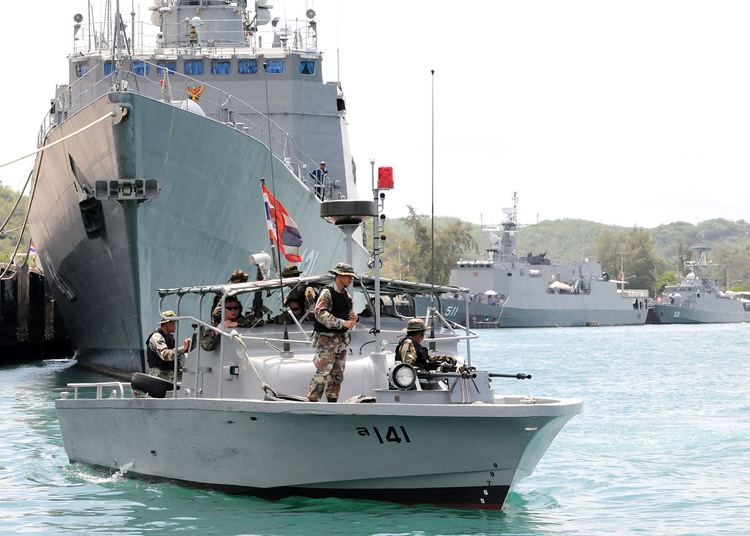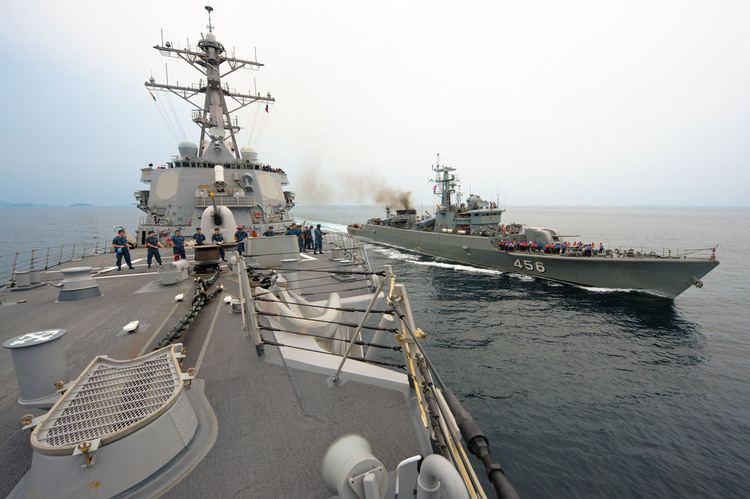Type Navy Founded 20 November 1906 | ||
 | ||
Allegiance King Maha Vajiralongkorn of Thailand Size 71,000 Active personnel(53,000 Navy personnel)(18,000 Marine Infantry) Motto ร่วมเครือนาวี จักยลปฐพีไพศาล (Join the Navy to see the world) Similar Royal Thai Air Force, Royal Thai Army, Royal Thai Marine Corps, Royal Thai Armed Forces, Ministry of Defence Profiles | ||
The Royal Thai Navy or RTN (Thai: กองทัพเรือไทย; rtgs: Kong Thap Ruea Thai) is the naval force of Thailand and part of the Royal Thai Armed Forces. It was established in the late-19th century. Admiral Prince Abhakara Kiartiwongse (1880–1923) is considered "the father of the Royal Thai Navy". Similar to the organisational structure of the United States, the Royal Thai Navy includes the naval fleet and the Royal Thai Marine Corps. The Royal Thai Navy operates out of Sattahip Naval Base in Sattahip Bay. Thailand is the only Southeast Asian country that operates an aircraft carrier, though it is used as a pure helicopter carrier with the retirement of the Harrier fighter wing. Thailand was the second Asian nation to acquire submarines, following Japan, but has had no submarines since 1950.
Contents
- Vietnam War
- Current
- RTN response to criticism
- Command and control
- Naval Area Commands
- Royal Thai Naval Air and Coastal Defence Command
- District forces
- Naval Aviation
- Other forces
- Equipment
- Procurement plans
- Humanitarian relief operations
- References

The United States Navy and Royal Thai Navy conduct the annual joint operation Cooperation Afloat Readiness and Training (CARAT). CARAT is an annual series of bilateral maritime training exercises of the US Navy and the armed forces of Singapore, Thailand, Malaysia, Indonesia, Brunei, and Philippines.
Vietnam War
In support of Vietnam during the Vietnam War, two Royal Thai Navy vessels undertook operations in South Vietnam.
Current

The navy's combat forces included the Royal Fleet and the Royal Thai Marine Corps. The 130 vessels of the Royal Fleet included frigates equipped with surface-to-air missiles, fast attack craft armed with surface-to-surface missiles, large coastal patrol craft, coastal minelayers, coastal minesweepers, landing craft, and training ships.

The mission space of the Thailand navy includes the Thai Gulf and the Indian Ocean, which are separated by land, as well as rivers. Naval affairs were directed by the country's most senior admiral from his Bangkok headquarters. The naval commander in chief was supported by staff groups that planned and administered such activities as logistics, education and training, and various special services. The headquarters general staff functioned like those of corresponding staffs in the army and air force command structures.
RTN response to criticism

A 20 April 2014 Bangkok Post editorial said that a major news agency won the Pulitzer Prize for their work exposing Thailand's involvement in the trafficking of Myanmar's oppressed Rohingya minority through what it called a "tropical gulag". The next day, two journalists running a small, independent website in Phuket were formally indicted for criminally defaming the Royal Thai Navy by quoting part of the award-winning report. "Phuketwan editor Alan Morison and journalist Chutima Sidasathian, who had played a substantial role in the Reuters investigation, had to worry about the threat of seven years in jail and whether they would be granted bail". The lawsuit was not dropped. Phuketwan spent years defending itself and eventually won in 2015 but had to close down because its funds were exhausted.
Command and control
The Royal Thai Navy is commanded by the Commander-in-Chief of the Royal Thai Navy, currently Admiral Surasak Rounroengrom, who was appointed in 2011. The Royal Thai Navy headquarters is in Bangkok.
Naval Area Commands
The Royal Thai Navy operates three naval area commands:
Royal Thai Naval Air and Coastal Defence Command
Coastal Defence Command was formed in 1992 under the control of the Royal Fleet Headquarters, with one coastal defence regiment (equipped with 155 mm artillery) and one air defence regiment (equipped with 40 mm and 37 mm anti-aircraft guns as well as HN-5A MANPADs). Personnel were initially drawn from the Royal Thai Marine Corps, but are now being recruited directly. The First Coastal Defence Regiment is based near the Marine Corps facility at Sattahip. The First Air Defence Regiment was near the Naval Air Wing at Utapao. Coastal Defence Command was greatly expanded in 1992, following the government's decision in 1988 to charge the RTN with the responsibility of defending the entire eastern seaboard and Southern Seaboard Development Project. The Second Air Defence Regiment, based at Songkhla, was then formed the following year. Some analysts believe that this element will eventually grow to a strength of up to 15,000 personnel. They are interested in S-300 or S-400 SAMs to upgrade their air defence system.
District forces
Naval Aviation
The RTN has two air wings, operating 40 fixed-wing aircraft and 30 helicopters from Utapao, Songkhla and Phuket. The First Royal Thai Navy wing has four squadrons; the Second Royal Thai Navy wing has three squadrons.
Other forces
The Royal Thai Navy also consists of a Royal Thai Marine Corps division, an Air and Coastal Defence Division, Underwater Demolition Assault Unit and a Riverine Patrol Regiment.
Equipment
Procurement plans
In January 2017 the Thai National Legislative Assembly, the country's "rubber-stamp parliament", approved the expenditure of 13.5 billion baht (US$383 million) to buy one Chinese S26T submarine. It is projected to be the first of a three-boat, US$1 billion acquisition. The sub is expected to be delivered in about 2023. The Thai navy's submarine squadron has trained in Germany and South Korea but has no submarines—its last sub was decommissioned in 1950. It does have a submarine headquarters: in July 2014 a US$17.3 million submarine headquarters and training center was opened at the Thai Navy's largest port in Sattahip. Prime Minister Prayut Chan-o-cha has explained that Thailand will buy submarines, "not for battle, but so that others will be in awe of us." Deputy Prime Minister and Defence Minister Gen Prawit Wongsuwon said that "...growing territorial threats and an increasing number of maritime missions has prompted the navy to strengthen its submarine units." There are plans to base one submarine at Mahidol Adulyadej Naval Dockyard in Sattahip District, Chonburi, one at a submarine dockyard off the Sattahip coastline, and one on the Andaman coast, in either Krabi or Phang Nga.
Humanitarian relief operations
Thailand worked with more than 60 nations in providing Humanitarian response to the 2015 Nepal earthquake. Operation Sahayogi Haat ("helping hands") was a US military relief operation delivering humanitarian assistance to victims of the April and May 2015 Nepal earthquakes. The Royal Thai Navy materially assisted relief efforts. A magnitude 7.8 earthquake struck the region of Kathmandu in Nepal on 25 April 2015. Operation Sahayogi Haat (Nepali: "helping hands") for humanitarian relief operations was put into action by Joint Task Force 505 on 6 May.
